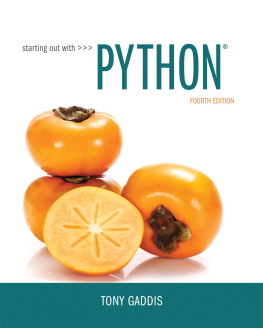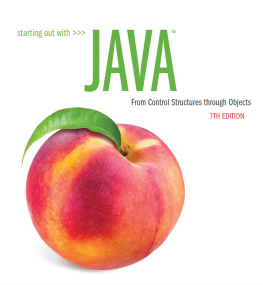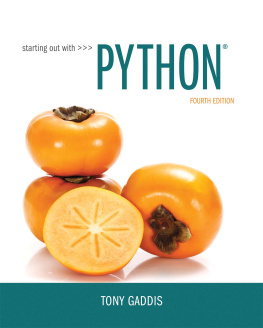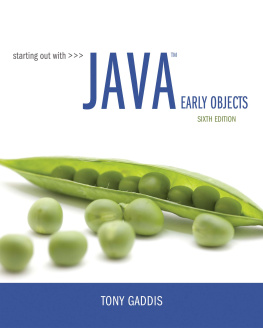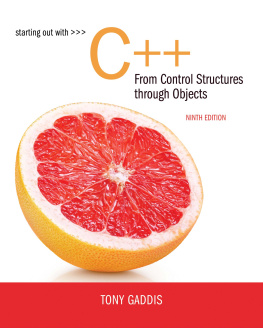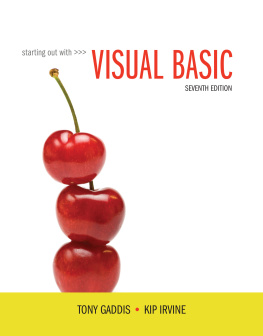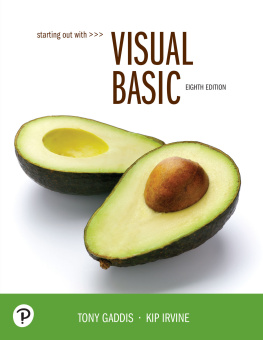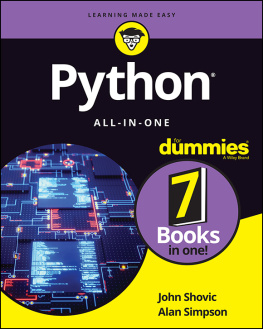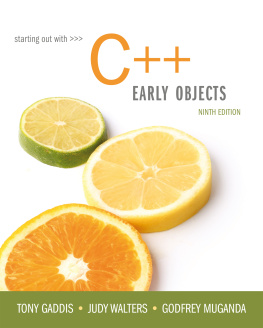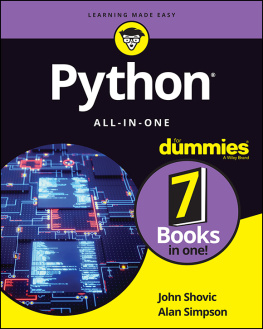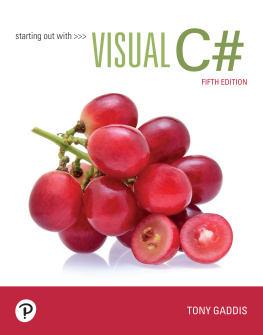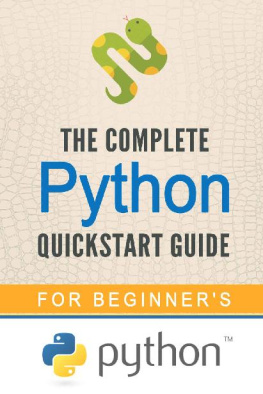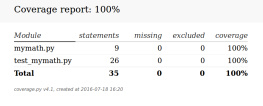Tony Gaddis - Starting Out with Python, 4/e
Here you can read online Tony Gaddis - Starting Out with Python, 4/e full text of the book (entire story) in english for free. Download pdf and epub, get meaning, cover and reviews about this ebook. year: 2017, publisher: Pearson, genre: Home and family. Description of the work, (preface) as well as reviews are available. Best literature library LitArk.com created for fans of good reading and offers a wide selection of genres:
Romance novel
Science fiction
Adventure
Detective
Science
History
Home and family
Prose
Art
Politics
Computer
Non-fiction
Religion
Business
Children
Humor
Choose a favorite category and find really read worthwhile books. Enjoy immersion in the world of imagination, feel the emotions of the characters or learn something new for yourself, make an fascinating discovery.
- Book:Starting Out with Python, 4/e
- Author:
- Publisher:Pearson
- Genre:
- Year:2017
- Rating:5 / 5
- Favourites:Add to favourites
- Your mark:
- 100
- 1
- 2
- 3
- 4
- 5
Starting Out with Python, 4/e: summary, description and annotation
We offer to read an annotation, description, summary or preface (depends on what the author of the book "Starting Out with Python, 4/e" wrote himself). If you haven't found the necessary information about the book — write in the comments, we will try to find it.
Starting Out with Python, 4/e — read online for free the complete book (whole text) full work
Below is the text of the book, divided by pages. System saving the place of the last page read, allows you to conveniently read the book "Starting Out with Python, 4/e" online for free, without having to search again every time where you left off. Put a bookmark, and you can go to the page where you finished reading at any time.
Font size:
Interval:
Bookmark:

Fourth Edition
Fourth Edition
Tony Gaddis
Haywood Community College

330 Hudson Street, New York, NY 10013
| Senior Vice President Courseware Portfolio Management: | Marcia J. Horton |
| Director, Portfolio Management: Engineering, Computer Science & Global Editions: | Julian Partridge |
| Portfolio Manager: | Matt Goldstein |
| Portfolio Management Assistant: | Kristy Alaura |
| Field Marketing Manager: | Demetrius Hall |
| Product Marketing Manager: | Yvonne Vannatta |
| Managing Producer, ECS and Math: | Scott Disanno |
| Content Producer: | Sandra L. Rodriguez |
| Composition: | iEnergizer Aptara, Ltd. |
| Cover Designer: | Joyce Wells |
| Cover Photo: | Westend61 GmbH/Alamy Stock Photo |
Credits and acknowledgments borrowed from other sources and reproduced, with permission, appear on the Credits page in the endmatter of this textbook.
Copyright 2018, 2015, 2012, 2009 Pearson Education, Inc. Hoboken, NJ 07030. All rights reserved. Manufactured in the United States of America. This publication is protected by copyright and permissions should be obtained from the publisher prior to any prohibited reproduction, storage in a retrieval system, or transmission in any form or by any means, electronic, mechanical, photocopying, recording, or otherwise. For information regarding permissions, request forms and the appropriate contacts within the Pearson Education Global Rights & Permissions department, please visit www.pearsoned.com/permissions/.
Many of the designations by manufacturers and seller to distinguish their products are claimed as trademarks. Where those designations appear in this book, and the publisher was aware of a trademark claim, the designations have been printed in initial caps or all caps.
The author and publisher of this book have used their best efforts in preparing this book. These efforts include the development, research, and testing of theories and programs to determine their effectiveness. The author and publisher make no warranty of any kind, expressed or implied, with regard to these programs or the documentation contained in this book. The author and publisher shall not be liable in any event for incidental or consequential damages with, or arising out of, the furnishing, performance, or use of these programs.
Pearson Education Ltd., London
Pearson Education Singapore, Pte. Ltd
Pearson Education Canada, Inc.
Pearson Education Japan
Pearson Education Australia PTY, Ltd
Pearson Education North Asia, Ltd., Hong Kong
Pearson Education de Mexico, S.A. de C.V.
Pearson Education Malaysia, Pte. Ltd.
Pearson Education, Inc., Hoboken
Library of Congress Cataloging-in-Publication Data
Names: Gaddis, Tony, author.
Title: Starting out with Python/Tony Gaddis, Haywood Community College.
Description: Fourth edition. | Boston : Pearson, [2018] | Includes index.
Identifiers: LCCN 2016058388 | ISBN 9780134444321 (alk. paper) | ISBN 0134444329 (alk. paper)
Subjects: LCSH: Python (Computer program language)
Classification: LCC QA76.73.P98 G34 2018 | DDC 005.13/3dc23 LC record available at https://lccn.loc.gov/2016058388
1 17

ISBN 10:0-13-444432-9
ISBN 13: 978-0-13-444432-1
 Location of Videonotes in the Text
Location of Videonotes in the TextWelcome to Starting Out with Python, Fourth Edition. This book uses the Python language to teach programming concepts and problem-solving skills, without assuming any previous programming experience. With easy-to-understand examples, pseudocode, flowcharts, and other tools, the student learns how to design the logic of programs then implement those programs using Python. This book is ideal for an introductory programming course or a programming logic and design course using Python as the language.
As with all the books in the Starting Out With series, the hallmark of this text is its clear, friendly, and easy-to-understand writing. In addition, it is rich in example programs that are concise and practical. The programs in this book include short examples that highlight specific programming topics, as well as more involved examples that focus on problem solving. Each chapter provides one or more case studies that provide step-by-step analysis of a specific problem and shows the student how to solve it.
Python is a fully object-oriented programming language, but students do not have to understand object-oriented concepts to start programming in Python. This text first introduces the student to the fundamentals of data storage, input and output, control structures, functions, sequences and lists, file I/O, and objects that are created from standard library classes. Then the student learns to write classes, explores the topics of inheritance and polymorphism, and learns to write recursive functions. Finally, the student learns to develop simple event-driven GUI applications.
This books clear writing style remains the same as in the previous edition. However, many additions and improvements have been made, which are summarized here:
New sections on the Python Turtle Graphics library have been added to . The Turtle Graphics library, which is a standard part of Python, is a fun and motivating way to introduce programming concepts to students who have never written code before. The library allows the student to write Python statements that draw graphics by moving a cursor on a canvas. The new sections that have been added to this edition are:
: Introduction to Turtle Graphics
: Determining the State of the Turtle
: Using loops to draw designs
: Modularizing Turtle Graphics Code with Functions
The new Turtle Graphics sections are designed with flexibility in mind. They can be assigned as optional material, incorporated into your existing syllabus, or skipped altogether.
has a new section on named constants. Although Python does not support true constants, you can create variable names that symbolize values that should not change as the program executes. This section teaches the student to avoid the use of magic numbers, and to create symbolic names that his or her code more self-documenting and easier to maintain.
has a new section on using the matplotlib package to plot charts and graphs from lists. The new section describes how to install the matplotlib package, and use it to plot line graphs, bar charts, and pie charts.
has a new section on creating graphics in a GUI application with the Canvas widget. The new section describes how to use the Canvas widget to draw lines, rectangles, ovals, arcs, polygons, and text.
Font size:
Interval:
Bookmark:
Similar books «Starting Out with Python, 4/e»
Look at similar books to Starting Out with Python, 4/e. We have selected literature similar in name and meaning in the hope of providing readers with more options to find new, interesting, not yet read works.
Discussion, reviews of the book Starting Out with Python, 4/e and just readers' own opinions. Leave your comments, write what you think about the work, its meaning or the main characters. Specify what exactly you liked and what you didn't like, and why you think so.

